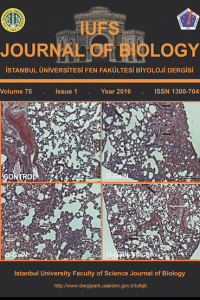Interactive effect of static magnetic field and abiotic stressors on growth and biochemical parameters of germinating wheat cultivars
Abstract
In this study, the effects of the individual and combined application of the static magnetic field and
abiotic stressors (60 gL-1 PEG6000 (as a drought stress inducer) or 100 mM NaCI (as a salinity stress
inducer)) on the cultivars of germinating wheat were investigated by assessing growth, biochemical
and antioxidant defence parameters. The seeds of Nina and Flamura-85 species of bread wheat were
exposed to 2.9-4.7 mT static magnetic flow density for a period of 0, 2.2 and 19.8 seconds on a band
turning with the speed of 1 ms-1. Moreover, this magnetic field application was performed together with
abiotic stressors and separately. The growth parameters of both wheat cultivars increased under the static
magnetic field applications, while they decreased when subject to the abiotic stress application than the
control. The application of the static magnetic field together with abiotic stressors statistically increased
the amount of • OH and H2O2 in root samples, and the total Chl, Chl a and Chl b amounts in leaf samples.
The application of the static magnetic field together with abiotic stressors or separately significantly
increased antioxidant enzyme activities (SOD, POD, CAT, APX and GR), and GSH and GSSG content
in all experimental groups when compared to the control. Consequently, that the application of the
magnetic field triggers the antioxidant defence parameters reduced the negative effects of drought and
salinity stresses on the growth parameters in both species.
Keywords
Antioxidant defence parameters biochemical parameters growth parameters static magnetic field salinity drought wheat
References
- Aebi H. (1984) Catalase in vitro. Methods Enzymology, 105: 121-6.
- Bailly C. (2004) Active oxygen species and antioxidants in seed biology. Seed Science Research,14: 93-107.
- Benzie I.F.F. and Strain J.J. (1996) Ferric reducing ability of plasma (FRAP) as a measure of antioxidant power: the FRAP. Analytical Biochemistry, 239: 70–6.
- Bhardwaj J., Anand A. and Nagarajan S. (2012) Biochemical and biophysical changes associated with magnetopriming in germinating cucumber seeds. Plant Physiology and Biochemistry, 57: 67-73.
Abstract
References
- Aebi H. (1984) Catalase in vitro. Methods Enzymology, 105: 121-6.
- Bailly C. (2004) Active oxygen species and antioxidants in seed biology. Seed Science Research,14: 93-107.
- Benzie I.F.F. and Strain J.J. (1996) Ferric reducing ability of plasma (FRAP) as a measure of antioxidant power: the FRAP. Analytical Biochemistry, 239: 70–6.
- Bhardwaj J., Anand A. and Nagarajan S. (2012) Biochemical and biophysical changes associated with magnetopriming in germinating cucumber seeds. Plant Physiology and Biochemistry, 57: 67-73.
Details
| Journal Section | Research Articles |
|---|---|
| Authors | |
| Publication Date | May 15, 2017 |
| Submission Date | May 16, 2017 |
| Published in Issue | Year 2016 Volume: 75 Issue: 1 |


